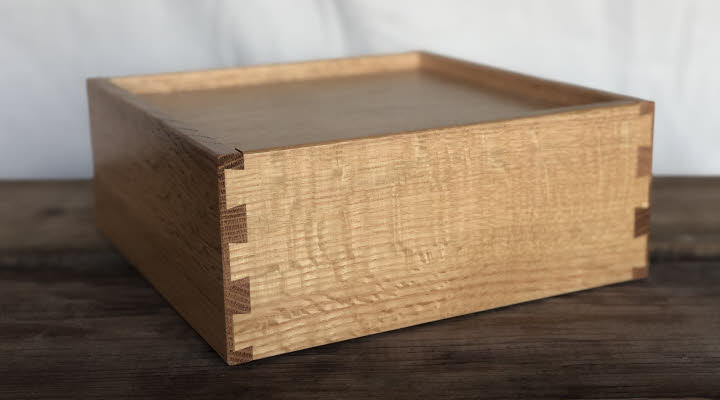Drawer Boxes
At Scherr's we make our drawer boxes with traditional dovetail joinery—specifically, Half-Blind Dovetails. See the image of a box made in our shop to the right (or below if on mobile):
If you don't already know, the dovetail joint is one that has stood the test of time in quality cabinetry and carpentry. Creating this joint is often complex and time-consuming—which is why you see less and less of it in modern cabinetry. There are many other "satisfactory" ways to build drawer boxes that are fast and easy, but in this case we prefer to go the extra mile.
We'll talk a little bit here about why we stand behind the dovetail, but feel free to skip this section to get straight to figuring what we offer and how to order.

A Brief History
The dovetail joint has been around a long time—a very long time. This type of joint used to be common, less-so now. In fact, furniture and artifacts with this joinery method have even been found in the tombs of rulers from some of the oldest civilizations we know about. The fact that this joint is present in ancient workmanship from separate cultures across the world is probably a testament that the dovetail joint was born out of true logical design. It just makes sense! In ancient times, how else could two boards be attached to one another at a 90 degree angle without the use of fasteners or adhesives? Old (quality) woodworking methods are rife with joinery that interlocks. The how and where wood interlocks within the infinite ways multiple pieces of wood can come together in furniture, cabinetry, and construction purposes make up the art of joinery. Different types of joints have their own strengths and weaknesses—as well as their own aesthetic appeal. "Ah ha! But, why not use a bracket or a screw designed for this purpose? What's wrong with glue and a staple gun? Most drawers are made that way now!" So, indeed, why not join the modern era as well as the plethora of giant cabinet makers and use some good quality metal fasteners? Nails, screws, staples, brads, brackets, and connection plates are so widespread and cheap that a person would be a fool not to use them... unless... unless using fasteners over good joinery provided no real structural advantage over traditional methods. This is why we adhere to traditional joinery from time to time. While the dovetail has been used for many purposes in carpentry, its most common use is in drawer boxes. This is where the dovetail shines. Why?
Keep in mind what was said before. Much of traditional carpentry is made up of joints that interlock. Look at the image above where the sides of that box comes together. You will see a zig-zagging trapazoid pattern cut right into the wood on both pieces. The patterned cuts are identical but you will also notice that one is the inverse of the other and also turned 90 degrees. In this way the one side can slide into the void created by the other where it interlocks. Once slid into place, the two pieces can only come apart the way they were put together, but every other direction they are locked together! In the image above, the side of the box that's to the left
.png)




